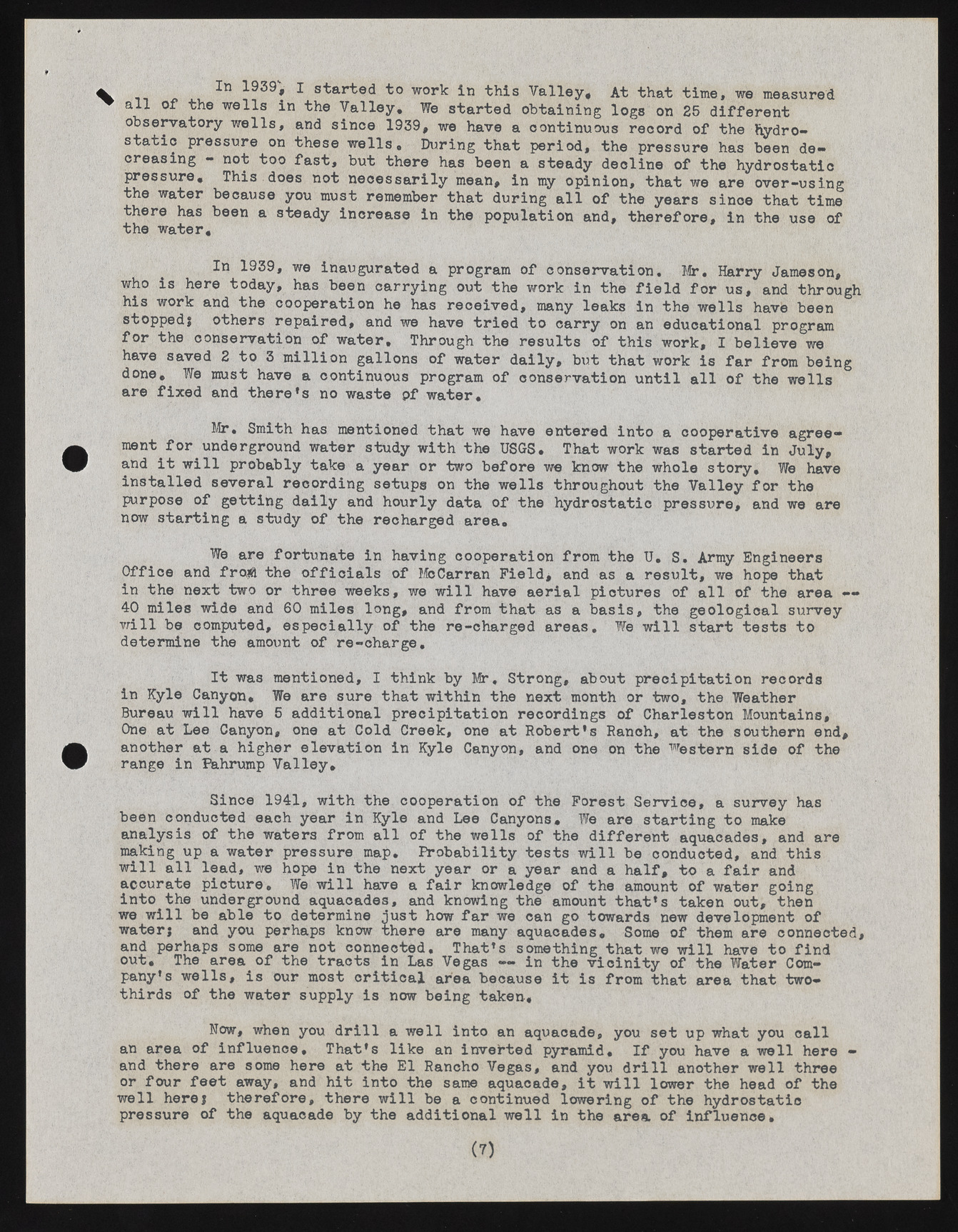Copyright & Fair-use Agreement
UNLV Special Collections provides copies of materials to facilitate private study, scholarship, or research. Material not in the public domain may be used according to fair use of copyrighted materials as defined by copyright law. Please cite us.
Please note that UNLV may not own the copyright to these materials and cannot provide permission to publish or distribute materials when UNLV is not the copyright holder. The user is solely responsible for determining the copyright status of materials and obtaining permission to use material from the copyright holder and for determining whether any permissions relating to any other rights are necessary for the intended use, and for obtaining all required permissions beyond that allowed by fair use.
Read more about our reproduction and use policy.
I agree.Information
Digital ID
Permalink
Details
More Info
Rights
Digital Provenance
Publisher
Transcription
% In 19Z9"» 1 started to work in this Valley. At that time, we measured all of the wells in the Valley, We started obtaining logs on 25 different observatory wells, and since 1939. we have a continuous record of the hydrostatic pressure on these wells. During that period, the pressure has been decreasing - not too fast, but there has been a steady decline of the hydrostatic pressure. This does not necessarily mean, in my opinion, that we are over-using the water because you must remember that during all of the years sinoe that time there has been a steady increase in the population and, therefore, in the use of the water. In 1939, we inaugurated a program of conservation. Mr. Harry Jameson, who is here today, has been carrying out the work in the field for us, and through his work and the cooperation he has reoeived, many leaks in the wells have been stopped* others repaired, and we have tried to carry on an educational program for the conservation of water. Through the results of this work, I believe we have saved 2 to 3 million gallons of water daily, but that work is far from being done. We must have a continuous program of conservation until all of the wells are fixed and there's no waste pf water, Mr. Smith has mentioned that we have entered into a cooperative agreement for underground water study with the USGS. That work was started in July, and it will probably take a year or two before we know the whole story. We have installed several recording setups on the wells throughout the Valley for the purpose of getting daily and hourly data of the hydrostatic pressure, and we are now starting a study of the recharged area. We are fortunate in having cooperation from the U, S. Army Engineers Office and fro$ the officials of McCarran Field* and as a result, we hope that in the next two or three weeks, we will have aerial pictures of all of the area — 40 miles wide and 60 miles long, and from that as a basis, the geological survey will be computed, especially of the re-charged areas. We will start tests to determine the amount of re-charge. It was mentioned, I think by Mr. Strong, about precipitation records in Kyle Canyon, We are sure that within the next month or two, the Weather Bureau will have 5 additional precipitation recordings of Charleston Mountains, One at Lee Canyon, one at Cold Creek, one at Robert's Ranoh, at the southern end, another at a higher elevation in Kyle Canyon, and one on the Western side of the range in Pahrump Valley, Since 1941, with the cooperation of the Forest Service, a survey has been conducted each year in Kyle and Lee Canyons, We are starting to make analysis of the waters from all of the wells of the different aquacades, and are making up a water pressure map. Probability tests will be conducted, and this will all lead, we hope in the next year or a year and a half, to a fair and accurate picture. We will have a fair knowledge of the amount of water going into the underground aquacades, and knowing the amount that’s taken out, then we will be able to determine just how far we can go towards new development of water* and you perhaps know there are many aquacades. Some of them are connected, and perhaps some are not connected. That’s something that we will have to find out. The area of the tracts in Las Vegas — in the vicinity of the Water Company's wells, is our most oritical area because it is from that area that two-thirds of the water supply is now being taken. Now, when you drill a well into an aquacade, you set up what you call an area of influence. That's like an invented pyramid. If you have a well here — and there are some here at the El Rancho Vegas, and you drill another well three or four feet away, and hit into the same aquacade, it will lower the head of the well herej therefore, there will be a continued lowering of the hydrostatic pressure of the aquacade by the additional well in the area, of influence. (?)

